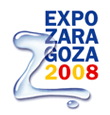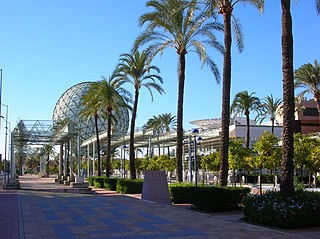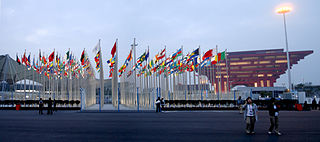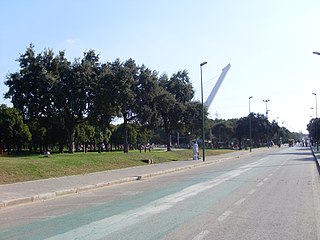
A world's fair, also known as a universal exhibition or an expo, is a large global exhibition designed to showcase the achievements of nations. These exhibitions vary in character and are held in different parts of the world at a specific site for a period of time, typically between three and six months.

The Bureau international des expositions is an intergovernmental organization created to supervise international exhibitions falling under the jurisdiction of the Convention Relating to International Exhibitions.
Taejon Expo '93 was a three-month international exposition held between Saturday, August 7, 1993 and Sunday, November 7, 1993 in the central South Korean city of Daejeon.

The Ibero-American Exposition of 1929 was a world's fair held in Seville, Spain, from 9 May 1929 until 21 June 1930. Countries in attendance of the exposition included: Portugal, the United States, Brazil, Uruguay, Mexico, Peru, Argentina, Chile, the Republic of Colombia, Cuba, Venezuela, the Dominican Republic, Bolivia, Panama, El Salvador, Costa Rica, and Ecuador. Each Spanish region and each of the provinces of Andalusia were also represented. Spain’s Dictator General Miguel Primo de Rivera gave the opening address. Primo de Rivera allowed the Spanish King Alfonso XIII to give the final words and officially open the exposition. The purpose of the exposition was to improve relations between Spain and the countries in attendance, all of which have historical ties with Spain through colonization or political union. Other countries were represented at the International section in Barcelona.

Expo 2005 was a world expo held for 185 days between Friday, March 25 and Sunday, September 25, 2005, in Aichi Prefecture, Japan, east of the city of Nagoya. Japan has also hosted Expo '70 Osaka, Expo '75 Okinawa, Expo '85 Tsukuba, and Expo '90 Osaka and will host Expo 2025 Osaka . The site of the expo would become the Expo 2005 Aichi Commemorative Park after it ended and is now the home of Ghibli Park.

Expo '98 was an official specialised World's Fair held in Lisbon, Portugal from Friday, 22 May to Wednesday, 30 September 1998. The theme of the fair was "The Oceans, a Heritage for the Future", chosen in part to commemorate 500 years of Portuguese discoveries. The Expo received over 10 million visitors in 132 days, while 143 countries and many organizations were represented.

Expo 2008 was an international exposition held from Saturday 14 June to Sunday 14 September 2008 in Zaragoza, Spain, with the theme of "Water and Sustainable Development". The exposition was placed in a meander of the river Ebro. It was coordinated by the Bureau International des Expositions, the organization responsible for sanctioning World's Fairs.

Isla de la Cartuja is an island in the Guadalquivir River at Seville, Spain.

L'Esposizione Internazionale Specializzata Genova '92 - Colombo '92 or more informally Expo 1992, was held in Genoa, Italy from 15 May to 15 August 1992. The theme was "Christopher Columbus, The Ship and the Sea", and the Expo was timed to celebrate the 500 years since the discovery of America by the Genoese sailor Christopher Columbus. Because of the theme, the expo was also known as Colombiadi. It was a specialized Exhibition with 54 countries represented. Total visitors were 694,800. The exposition ran at the same time as the larger and longer duration Seville Expo '92, a Universal Exposition, held in the city from whose port Columbus had sailed in 1492. The expo's logo was a "500" number with Genoa's flag; the mascot was a cat dressed like Christopher Columbus called "Gatto Cristoforo"

The Monastery of Santa María de las Cuevas, also known as the Monastery of the Cartuja (Charterhouse), is a religious building on the Isla de La Cartuja in Seville, southern Spain. The Andalusian Contemporary Art Center (The Centro Andaluz de Arte Contemporáneo (CAAC)) is now located on this site.

The Wharf of the Caravels is a museum in Palos de la Frontera, in the province of Huelva, autonomous community of Andalusia, Spain. Its most prominent exhibits are replicas of Christopher Columbus's boats for his first voyage to the Americas, the Niña, the Pinta, and the Santa María. These were built in 1992 for the Celebration of the Fifth Centenary of the Discovery of the Americas. The replica caravels were built between 1990 and 1992, put through shakedown voyages and then, in 1992, sailed the route of Columbus's voyage.

This article contains the details of the pavilions at Expo 2010. The 2010 World Expo Shanghai is the largest Expo site ever, covering more than 5.2 square kilometers and containing more than 70 exposition pavilions. More than 190 countries and 50 international organizations registered to participate in the 2010 Shanghai Expo. After the six-month run, the Expo had attracted well over 70 million visitors. The Expo 2010 is also the most expensive fair in the history of the World's Fair, with more than 45 billion US dollars invested by the Chinese Government.

Hotel Alfonso XIII is a historic hotel in Seville, Spain, located on Calle San Fernando, next to the University of Seville. Designed by the architect José Espiau y Muñoz, it was built between 1916 and 1928 especially for the Ibero-American Exposition of 1929. It officially opened on April 28, 1929, with a sumptuous banquet attended by King Alfonso XIII and Queen Victoria Eugenie of Battenberg. The hotel is owned by the City of Seville and managed by The Luxury Collection division of Marriott International.

The Cartuja 93 park is a technological and scientific complex located in Seville, in the Isla de la Cartuja, next to the Monastery of Santa Maria de las Cuevas. It started in 1993 to exploit the showground and buildings inherited from the 1992 Universal Exposition Seville Expo '92.

The Puente de la Barqueta, officially named Puente Mapfre, is a bridge in the city of Seville, which spans the Alfonso XIII channel of the Guadalquivir river. It constituted one of the main means of access to the Isla de la Cartuja.

Seville, the capital of the region of Andalusia in Spain, has 11 districts, further divided into 108 neighbourhoods.
There are numerous sights and landmarks of Seville, Spain. The most important sights are the Alcázar, the Seville Cathedral, and the Archivo General de Indias, which are UNESCO World Heritage Sites.

Alamillo Park is a metropolitan park located between the town of Santiponce (Sevilla) and Seville, Spain. The park is scheduled to begin an expansion that will make it one of Spain's largest urban parks, reaching 120 hectares in the summer of 2013.

Manuel Olivencia Ruiz was a Spanish lawyer with a career as a professor, economist, and diplomat. He worked at the University of Seville and organized Seville Expo '92.

The Columbus Quincentenary (1992) was the 500th anniversary of Christopher Columbus' 1492 arrival in America. Similar to Columbus Day, the annual celebration of Columbus' arrival, the quincentenary was viewed contentiously, as different cultures and peoples had different ways of understanding Columbus' role in history. Certain institutions sought to celebrate this anniversary in commemoration of Columbus' momentous colonial and imperial achievements. Spain's Universal Exposition of Seville (1992) was elaborately planned to highlight Columbus' work and the overall European Age of Discovery. Italy's International Exposition of Genoa (1992) was themed "Christopher Columbus, The Ship and the Sea." In 1984, the United States designated the Christopher Columbus Quincentenary Jubilee Commission to execute a commemoration in honor of Columbus. In total, over 20 countries, including several Latin American countries and Japan, had committees to plan quincentennial celebrations.






















